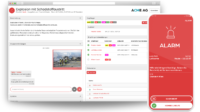Evacuation drills: 5 tips for successful planning

Evacuation drills are an essential part of workplace safety. Whether it’s a fire, bomb threat, or hazardous material leak. A well-planned and well-executed evacuation can save lives.
In this article, you’ll learn how to:
- plan your next evacuation drill effectively, and
- avoid common mistakes in preparation and execution.
Learn more: How alerting because of terror and rampage works
1.666 alarms per second
safeREACH as your powerful emergency notification system with up to 100.000 alarms per minute. Successfully used by multinational corporations, medium-sized companies and public authorities. ISO-certified server infrastructure.


Why evacuation drills are so important
Evacuation drills are essential for ensuring that people can act quickly and in an organized way during an emergency. They simulate real-life incidents such as fires, bomb threats, or chemical leaks, helping organizations prepare for worst-case scenarios.
Every organization, regardless of size, has a duty of care to protect staff and visitors. Regularly planned evacuation drills reduce panic, improve coordination, and ensure that rescue operations can be carried out effectively.
▶︎ Learn more: How safeREACH works
Over 20 years of experience in alerting
IT alerting, fire alarms, alerting company first responders and much more. ISO-certified server infrastructure. Used by SMEs, corporations, authorities and public organisations.

Five tips for a successful evacuation drill
1) Announce the drill in advance
An evacuation drill should feel realistic, but never cause panic. Inform all employees early about the date, time, and scenario. Notify external partners such as facility management, fire departments, or security teams so that no real emergency responses are triggered.
▶︎ Learn more: How safeREACH saves valuable time during digital alerting
2) Define the type of alarm
Whether you use sirens, public address systems, or digital alerting via safeREACH, define the alerting method in advance. Digital alerting systems have the advantage of reaching large groups simultaneously and sharing clear instructions within seconds.
▶︎ Learn more: Safety Moments: Brief instructions with a big impact
3) Prepare evacuation assistants
Evacuation assistants play a critical role in safely guiding people out of a building.
- Identification: Make sure helpers are clearly visible, e.g., with vests or colored armbands.
- Task Assignment: Define which areas of the building each assistant is responsible for.
- Control Mechanism: Mark cleared rooms clearly (for example, with tape or signs) so that no one is overlooked during the evacuation.
▶︎ Learn more: Louvre Heist 2025
1.666 alarms per second
safeREACH as your powerful emergency notification system with up to 100.000 alarms per minute. Successfully used by multinational corporations, medium-sized companies and public authorities. ISO-certified server infrastructure.

4) Assign a coordinator at the assembly point
Designate one responsible person (or team) to oversee the assembly point. This person coordinates information, checks attendance, and reports missing persons to emergency services if necessary.
Clear leadership at the assembly point helps ensure that everyone is accounted for and that emergency responders receive accurate updates.
▶︎ Learn more: The biggest challenges in organizational crisis communication
5) Assign observers and conduct a debrief
To learn effectively from a drill, you need independent observers. Assign two or three people to monitor the process objectively and document findings using a checklist.
After the drill, conduct a debriefing session with all participants. Discuss what worked well and where improvements are needed. This feedback is invaluable for optimizing future drills and real-life emergency responses.
▶︎ Learn more: How your company can benefit from a specialised crisis communication solution
Timeline for an evacuation drill
A clear schedule helps keep everyone informed and ensures enough time for preparation, execution, and follow-up.
| Phase | When | Tasks |
|---|---|---|
| 1) Planning | 4-6 weeks before drill |
|
| 2) Preparation | 1-2 weeks before drill |
|
| 3) Execution | On the day of the drill |
|
| 4) Follow-up | Immediately after the drill |
|
Keep your organization’s specific requirements in mind when planning drills. For sites with shift work or large facilities, special procedures or multiple sessions may be necessary.
▶︎ Learn more: Alert App of safeREACH
1.666 alarms per second
safeREACH as your powerful emergency notification system with up to 100.000 alarms per minute. Successfully used by multinational corporations, medium-sized companies and public authorities. ISO-certified server infrastructure.

Key points at a glance
An evacuation drill is only effective if all core aspects are covered. Below is a summary of the most important points:
- Advance notice: Prevents panic and confusion.
- Clear alerting procedures: Defined responsibilities and communication paths, e.g., via safeREACH.
- Visible evacuation assistants: Easy identification and clear role assignment.
- Assembly point coordination: Ensures accountability for all employees.
- Observation and review: Feedback and checklists for continuous improvement.
By following these steps, your organization will stay in control even in high-stress situations.
▶︎ Learn more: Alerting during evacuation with safeREACH
Definitions of important terms
Evacuation Assistant
Individuals who help direct people out of the building, instruct colleagues, and verify that areas have been cleared.
Assembly Point
A designated safe area outside the building where all employees gather after an evacuation.
Alerting System
A digital or organizational solution used to trigger and transmit warnings or evacuation orders to predefined groups.
Checklist
A standardized document used to capture observations, responsibilities, and follow-up actions during and after a drill.
Some of these terms (e.g., assembly point) may be legally required; others can be adapted or renamed to fit your organization.
Further relevant terms:
▶︎ FORDEC
▶︎ Incident Definition
▶︎ Business Continuity Management
▶︎ Emergency plan
Over 20 years of experience in alerting
IT alerting, fire alarms, alerting company first responders and much more. ISO-certified server infrastructure. Used by SMEs, corporations, authorities and public organisations.

Conclusion: evacuation drills save lives
Evacuation drills are more than a regulatory checkbox. They are the best preparation to prevent panic, protect lives, and keep people moving safely out of danger. Use the insights from each drill to refine processes. With the right planning, regular practice, and modern alerting systems like safeREACH, your organization is prepared for a wide range of scenarios.
Learn more about safeREACH:
▶︎ safeREACH Cockpit
▶︎ safeREACH Admin Interface
▶︎ Integrations and Interfaces
▶︎ FAQ about safeREACH
The information provided here is based on established best practices. Each organization is responsible for implementing and validating its own procedures; no legal liability is assumed.
